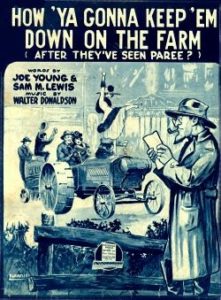In his book, Return to Order, author John Horvat described a spirit of unrestraint that dominated culture and economy, which he called frenetic intemperance. The following article is part of a series of articles written by history teacher Edwin Benson that explains some stages by which America adopted this spirit of frenetic intemperance and its consequence in society. His second article deals with the growing rejection of traditional moral limitations in American society at the beginning of the twentieth century and the unforeseen effect of World War I.In the first two decades of the twentieth century, frenetic intemperance in the United States was largely seen in the expansion of government power beyond the limits spelled out in the Constitution. This intemperance came under the guise of “progressive” legislation and took shape through the actions of politicians led by Presidents Theodore Roosevelt and Woodrow Wilson.

At the same time, frenetic intemperance was taking on another form as ancient standards of Christian morality were broken down. This growing rejection of traditional moral limitations can be traced to three sources—the rapid growth of American cities, the popularity of motion pictures, and an unforeseen effect of World War I.
Rapid industrialization brought with it the rapid growth of the city. The world before the automobile was a world in which one needed to walk to work. The worker’s home needed to be as near his workplace as physically possible. The then-common twelve-hour workday left him with little energy for a long walk home.
The farm villages, in which many of those workers had been raised, were insular places. Most people spent their time surrounded by people to whom they were closely related. Most of the work on a family farm was done by the family itself. Church and school needed to be close to the farm because most travel was done at speeds of less than five miles per hour. That meant that one knew only a small number of families. For children, fellow students were also those they saw at Church. The parents of your friends were also the friends of your parents—and often their relatives as well. When the time came to choose a spouse, chances were very good that the two young people had known each other since childhood. Social standards were well-known as were the consequences of violating them.
Life in a city, or even a factory town, was very different. Hundreds of men might work in a single factory. That meant that hundreds of families occupied less space than a single farm. Since such factories were also magnets for immigrants, neighbors might have been born in other countries. Your parents might not even speak the same language as the parents of your friends.
In this new world, it was often the young who were better able to function successfully.[1] This, in turn, disrupted the process by which traditional values were passed from the elder to the younger members of society. Social rules were more complex and the consequences of deviation were less certain.
The popularity of motion pictures sped up these social changes. Within both the town and city, motion pictures became an important, perhaps dominant, form of entertainment. Today, it is difficult to look at the grainy black-and-white movies of the silent era and grasp their significance. However, they were a potent force in altering the morality of a generation.
First, they were cheap. Even a worker subsisting on a dollar a day could squeeze out a nickel once a week to escape the gray world of the industrial town for a few hours.
Second, they were passive. It is easy to see a movie. Previous forms of entertainment required some sort of effort; playing a musical instrument, some test of manual ability like shooting or wrestling, or a display of mental agility as in a game of cards. To enjoy a movie, all one has to do is sit and let it sweep over you.
Third, they were viewed in the dark. The city offered few places in which one could feel a sense of privacy. Home, work, school, and the streets were all places where large numbers of people occupied a small space. The dark, relatively cool movie theater offered an individual or a couple a sense of being alone—or at least of being anonymous.
However, the most important aspect of the movies was the message contained in the films themselves. The twin capitals of the early movie industry were New York and Paris. To the viewer of silent films, it made little difference where, or in which language, the film was actually made. French subtitles could be taken out and English or German subtitles added without difficulty. Thus films easily transferred cultural images across the Atlantic.
No matter the side of the Atlantic on which the movie was made, the message was similar—and usually non-traditional. The main actors in the films, then and now, were people with a high degree of physical attractiveness. This created a standard of beauty which most could never attain—but to which many aspired. Unattractive characters in film were usually objects of humor or disgust.
 Another common area between early and modern film was the fact that most of those attractive actors behave with moral abandon. An intemperate life featuring late hours, loud and well-lubricated parties, and an often unseen—but very deep—source of money to pay for it all are standard fare for the movies.
Another common area between early and modern film was the fact that most of those attractive actors behave with moral abandon. An intemperate life featuring late hours, loud and well-lubricated parties, and an often unseen—but very deep—source of money to pay for it all are standard fare for the movies.
Finally, another highly significant cause of the moral intemperance of twentieth century America was the unprecedented nature of fighting in World War I and the reaction of American soldiers to it.
Officially, the United States joined the war in April of 1917. By that time, it had been going on for two and a half years. The land war in France had become bogged down in stalemate. The two sides were entrenched in such a way that neither side could effectively move the other.
Life in those trenches was basically life in an open sewer. Unprotected from the elements, they were often cold and always damp. Vermin of various types infested them. There was no place to eat, sleep, or attend to normal bodily functions in any way that could be called civilized. Humans literally lived like rats.
Then there was the horror of shelling. The only way that one side could inflict damage on the enemy without inviting massive casualties of its own was to use mortars to lob explosive shells into the enemy trenches. Since there was no way to know which area of the enemy trenches was occupied at any time, shelling became an inhuman numbers game. A shell would be lobbed into one part of the opposing trench. Then the mortar would be adjusted to send a shell into another part of the trench. This would be repeated over and over again. Day and night, the explosions would continue.
Clearly, this form of warfare was very unlike the traditional warfare of battling knights or daring cavalry charges. To many, there often seemed to be no place for courage, bravery, or even humanity. The only rule seemed to be survival.
[like url=https://www.facebook.com/ReturnToOrder.org]
This was the world into which about two million American men found themselves in the latter half of 1917. Many, perhaps most, of these men had never ventured more than twenty miles from home in their lives. Their training was the first time they met a person from another part of the country. Within six months they found themselves in an inhuman and brutal world where seeing others explode in a shell blast was nothing unusual.
Then, one morning, it ended. Past wars usually ended gradually. Armies moved across territory toward the enemy’s capital. Both victor and vanquished knew the direction in which the war was moving long before the end came. It was not so in World War I. Unbeknownst to the soldier in the trenches, the end of the war was being decided by German civilians, starved by a British naval blockade. The Kaiser was overthrown, and the government that replaced him agreed to an armistice. At 11:00 on the morning of November 11, 1918 the war was suddenly over.
Now, the world of the “doughboy” changed drastically once again. It took months to return those two million men to America. In the meantime, on the streets of Paris, they experienced a life that most had only seen in the movies.

The hedonistic nature of Parisian society was established by the “Enlightenment” and the French Revolution more than a century earlier. Flowing wine, suggestive music, lurid theater, and easily obtained pornography were available there well before the war began. These American men once again found themselves in a world they could not have imagined when growing up on their fathers’ farms. Additionally, the deaths of over a million Frenchmen left many French women trying to work out a future. American soldiers with a mademoiselle on their arms became a common sight.
Eventually, all those young men—knowledgeable far beyond their years—did get back home. Only two years older than when they had left, they returned to families and farms that were largely untouched by the war. To their parents, they looked the same as when they left and spoke with the same voices—but they were very different men indeed.
The extent and nature of the change varied with the individual. Many were supremely grateful to return to their familiar homes. Others were shell-shocked, and would carry the mental scars of their horrible experiences for the rest of their lives. Many who lived the nightmare of the trench and the liberty of Paris, returned with no sense of God or morality.
Those two million men would return to an America where urbanization and the movies made many of their generation receptive to the intemperate lessons they had learned in Belleau Wood and Paris. The “Roaring Twenties” would be the result.
________________________________
[1] A well-known example of this phenomenon was Andrew Carnegie, who came from Scotland at the age of twelve. Settling near Pittsburgh, Carnegie soon became the family breadwinner largely because his father was unable to adjust to industrial life.


